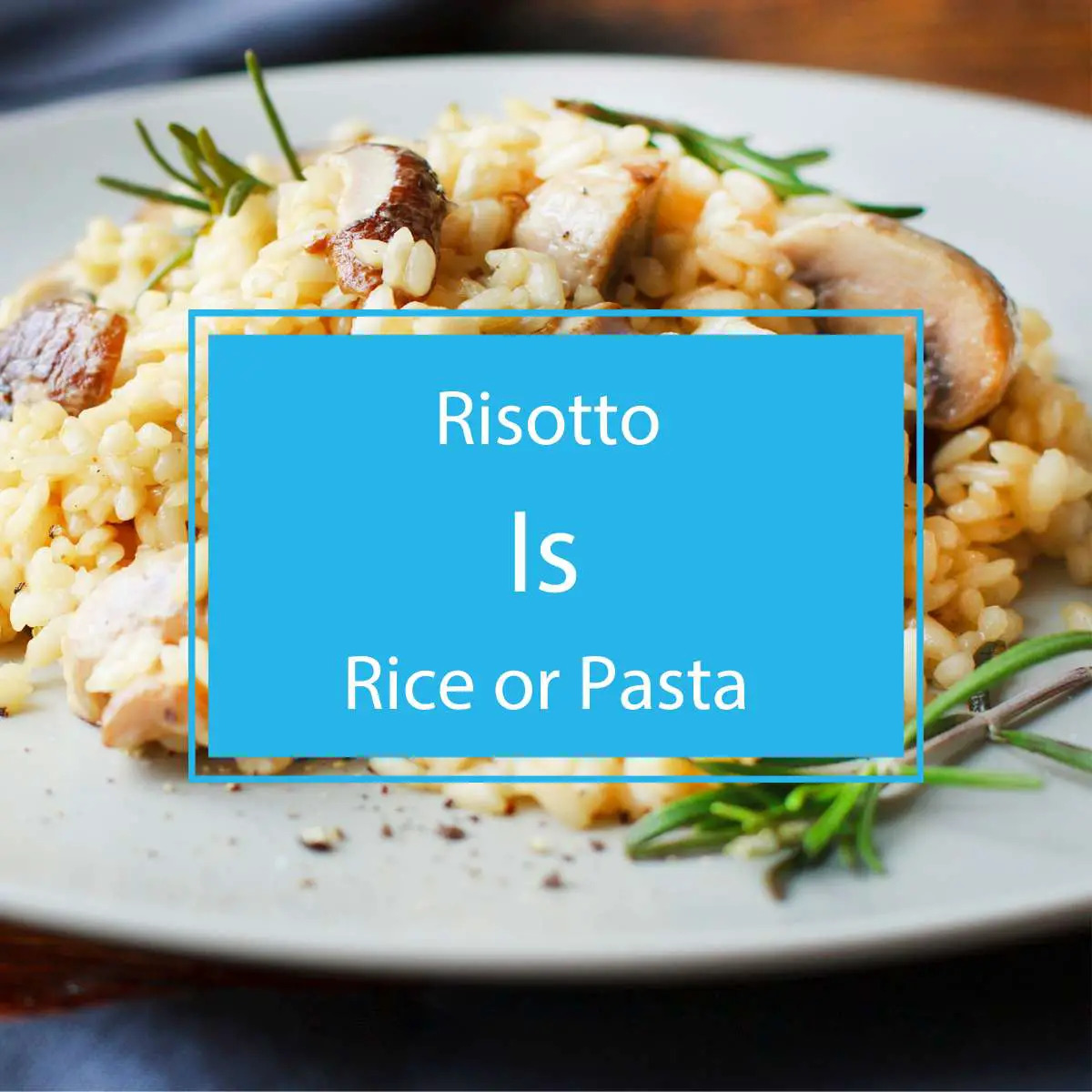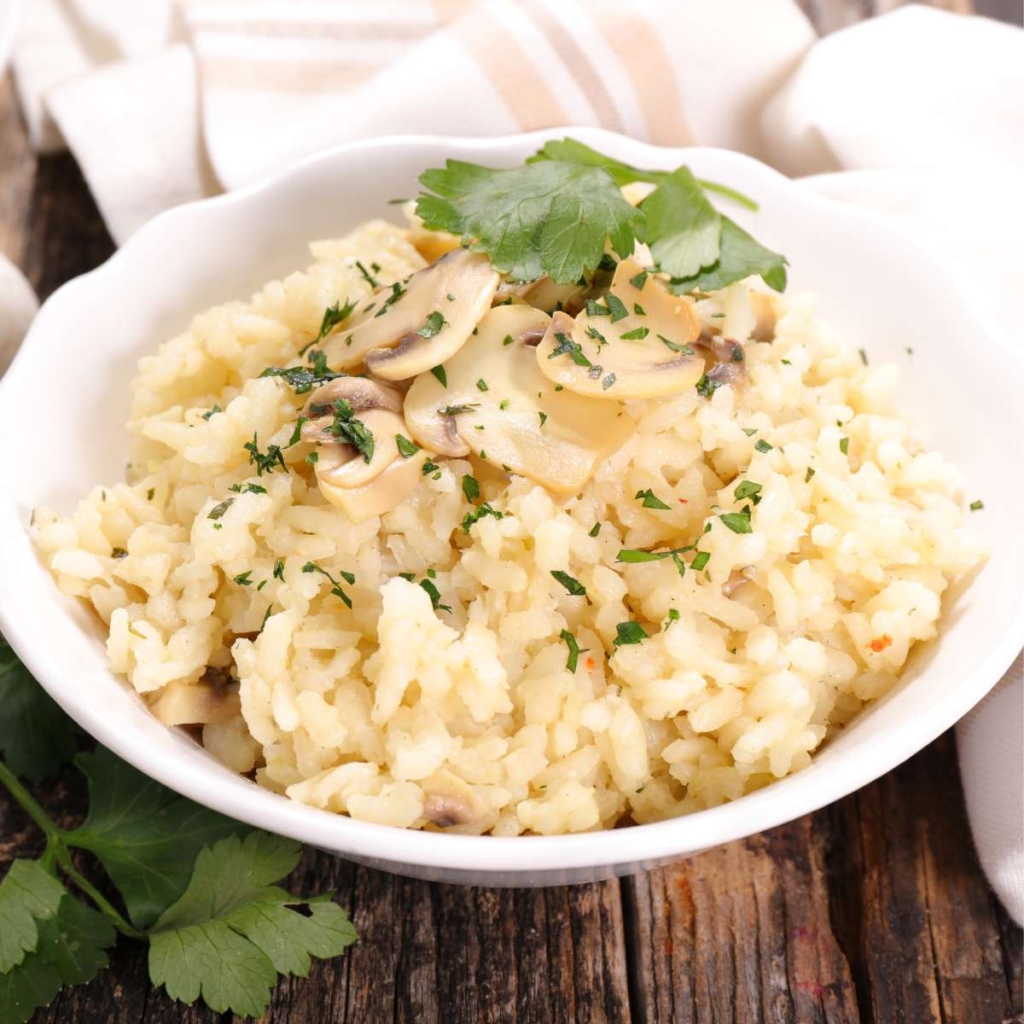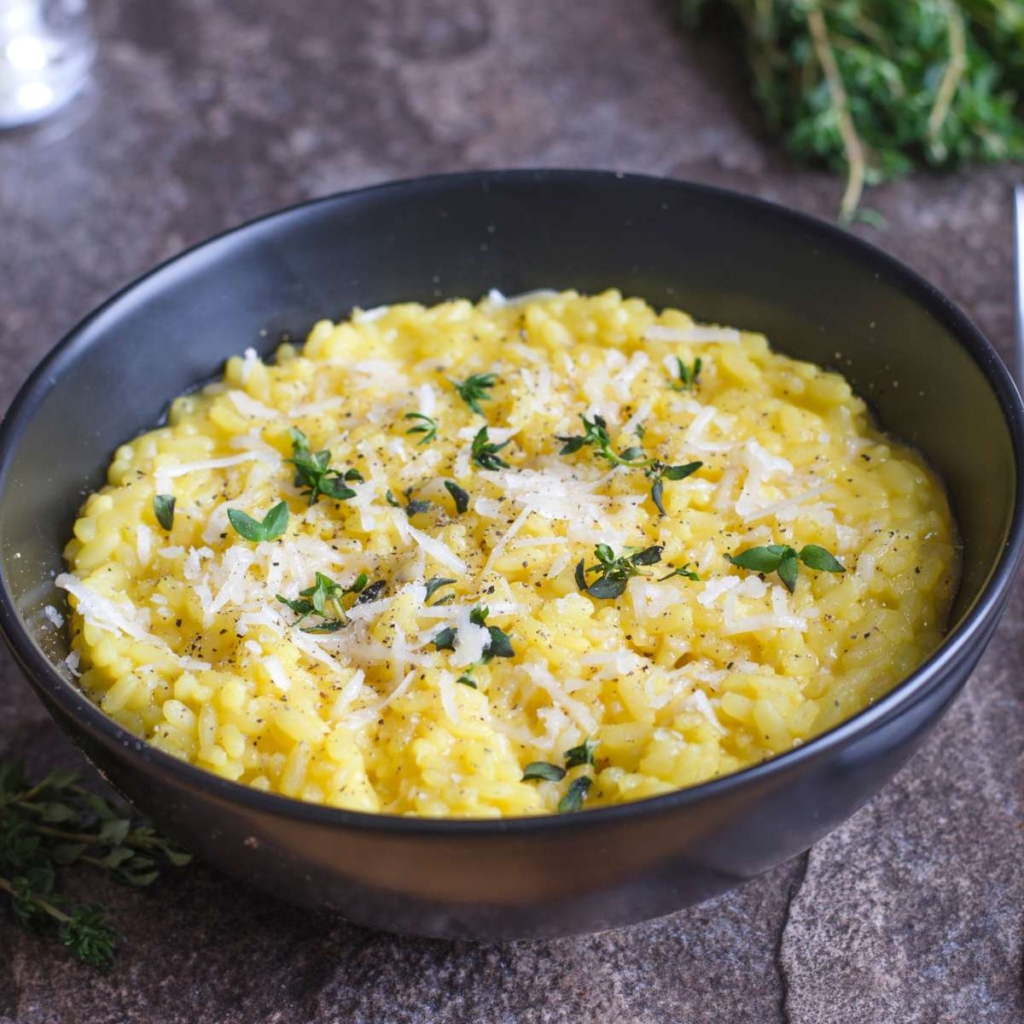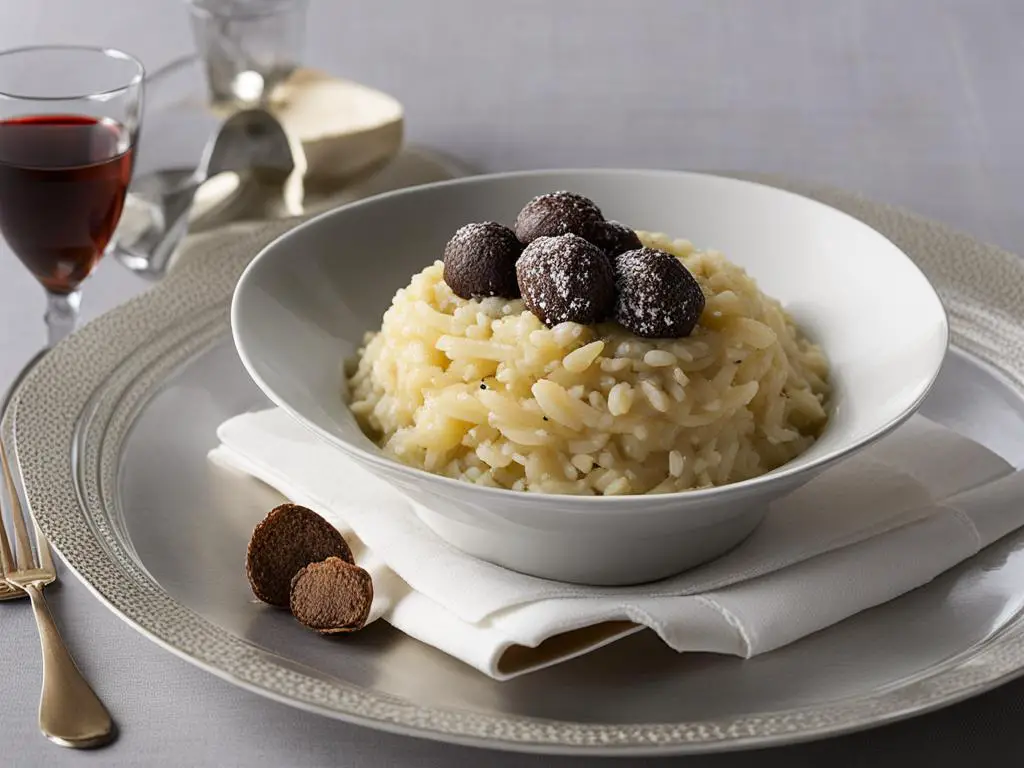Risotto is Rice or Pasta? Ah, risotto! The creamy, flavorsome dish that brings a taste of Italy to your plate. But have you ever wondered, is risotto made with rice or pasta? It’s time to uncover the truth behind this delicious Italian classic. So grab your forks and let’s dig in!
Risotto is a staple of Italian cuisine, known for its rich texture and mouthwatering flavors. But when it comes to the base ingredient, there’s been some confusion. Is it rice or pasta?
Well, the answer is rice! Risotto is made using short-grained rice varieties, such as Arborio, Carnaroli, or Vialone Nano. These special rice varieties have a high starch content, which gives risotto its signature creamy texture.
Now you might be wondering, where did risotto come from? It’s believed that rice was first introduced to Italy in the 10th century and slowly spread throughout the country. Northern Italy, specifically the regions of Vercelli and Lombardy, became the heartland of risotto production.
The early recipes for risotto used home-grown rice, and it wasn’t until later that specific varieties like Arborio, Carnaroli, and Vialone Nano gained popularity.
Key Takeaways:
- Risotto is made with rice, not pasta.
- Short-grained rice varieties like Arborio, Carnaroli, or Vialone Nano are used for a creamy texture.
- Risotto originated in Northern Italy, particularly in the regions of Vercelli and Lombardy.
Rice in Italy: A Slow Spread
Did you know that rice has a fascinating history in Italy? Despite its reputation as a pasta-loving nation, Italy has a long-standing relationship with this versatile grain. In fact, rice was traded in Italy as early as the 10th century, even during a time of religious divisions between Christian Italy and the Muslim Emirate of Sicily.
However, it wasn’t until the 14th century that rice cultivation began to take root in Northern Italy. Cistercian monks played a pivotal role in the spread of rice farming, particularly in Vercelli, located in the region of Piedmont. These dedicated monks recognized the potential of rice as a crop and began cultivating it in their fields.
By the 15th century, rice cultivation had expanded further into Lombardy, with Milan becoming a prominent rice-growing region. To this day, the fields around Milan are known for producing high-quality rice used in risotto and other traditional Italian dishes.
Interestingly, the early recipes involving rice in Italy were predominantly sweet. However, there are records of a proto-risotto recipe that included meat broth, rice, and eggs. It’s important to note that the rice used in these early recipes was different from the specialized varieties of rice, such as Arborio, Carnaroli, and Vialone Nano, that we associate with risotto today.
As rice cultivation slowly spread throughout Italy, it became an integral part of the country’s diverse culinary landscape, giving rise to beloved dishes like risotto. The journey of rice in Italy is a testament to the ingenuity and adaptability of Italian cuisine, which continues to bring us culinary delights rooted in tradition and innovation.
Variety is Key: Types of Risotto
Risotto is a dish that knows no bounds when it comes to variety. Across Italy, regional variations of this beloved dish showcase the culinary creativity and cultural diversity of the country. From classic recipes to exciting innovations, the world of risotto is a playground for flavor enthusiasts.
Here are some notable risotto varieties that highlight the regional influences and experimentation:
- Risotto Milanese: A rich and golden risotto made with beef bone marrow. This signature dish from Milan is known for its vibrant color and delicate flavor.
- Risotto Barolo: Hailing from the Piedmont region, this risotto gets its distinctive taste from Barolo, a famous red wine. The wine infuses the dish with a robust and complex flavor profile.
- Risotto Nero di Seppia: A Venetian specialty, this risotto is made with cuttlefish, giving it a striking black color. The combination of seafood and the ink of the cuttlefish creates a unique and delightful flavor.
- Risotto Pilota: Originating from Mantua, this risotto features a mix of beef and pork, which adds depth and heartiness to the dish. It’s a comforting and satisfying variation perfect for colder days.
But the exploration of risotto doesn’t stop there. Chefs like Christian and Manuel Costardi have taken risotto experimentation to a whole new level.
With their innovative recipes and bold ingredient choices, they have created risottos that push the boundaries of traditional flavors. Imagine risotto with leeks, lemon zest, caper powder, and a touch of chili garlic for a surprising burst of flavors.
“Risotto is like a blank canvas, waiting for your creative strokes. By embracing experimentation, you can unlock a world of exciting flavors and unexpected combinations.” – Christian and Manuel Costardi
The possibilities for flavor combinations in risotto are truly endless, limited only by your imagination. Whether you prefer to savor the classic regional varieties or embark on an adventurous culinary journey, risotto offers a delightful and satisfying experience.
The Rice Puzzle: Key Ingredient for Perfect Risotto
The success of a delectable risotto hinges on one crucial element: the type of rice used. Choosing the right rice is paramount in achieving the perfect texture, consistency, and flavor absorption in this iconic Italian dish.
While there are several rice varieties available, three types reign supreme: Arborio, Carnaroli, and Vialone Nano. Let’s dive deeper into the rice puzzle and unravel their secrets.
Arborio Rice: Creamy Indulgence
Arborio rice, known for its plump grains, is the most renowned rice variety for making risotto. Its high starch content releases gradually during cooking, creating a rich, creamy texture that is the hallmark of a superb risotto. With each velvety bite, Arborio rice delivers a luxurious mouthfeel, making it a favorite among risotto enthusiasts.
Carnaroli Rice: Firm, Yet Tender
If you prefer a risotto with a slightly firmer bite, look no further than Carnaroli rice. This variety boasts a higher amylose content, resulting in grains that maintain their shape and texture during cooking. Carnaroli rice gracefully absorbs the flavors of the broth while retaining a delightful al dente quality, balancing texture and taste to perfection.
Vialone Nano Rice: The Flavor Champion
Vialone Nano rice, hailing from the Veneto region, shines when it comes to enhancing the flavors of the broth. With its smaller grains and characteristic plumpness, Vialone Nano absorbs the surrounding liquid like a sponge. This quality makes it ideal for preparing risottos with abundant broths and ingredients, leading to a dish that bursts with vibrant flavors in every mouthful.

In the quest for exceptional risotto, quality is of utmost importance. Many renowned chefs, such as the acclaimed Costardi brothers, collaborate closely with local farms to ensure the finest rice for their risotto recipes. By prioritizing quality and selecting the right rice variety for each unique dish, you can elevate your risotto experience to new heights.
Now that we’ve completed the rice puzzle, let’s move on to the next section to uncover the secrets and techniques behind crafting a remarkable risotto.
The Art of Making Risotto: Tips and Techniques
Making risotto is an art that requires mastering a few key techniques to achieve that creamy, luxurious consistency you love. To help you become a risotto maestro, here are some essential tips and techniques that will elevate your risotto game.
Sautéing to Create Flavorful Foundations
Every great risotto starts with a flavorful base. Begin by sautéing finely chopped onions in olive oil or butter until they become translucent and fragrant. This simple step helps to develop a rich foundation of flavors that will infuse every grain of rice as it cooks.
Toasting Rice for Enhanced Flavor
After sautéing the onions, add the rice and toast it for a couple of minutes. This extra step might seem insignificant, but it makes a world of difference in flavor. Toasting the rice enhances its nutty aroma and adds complexity to the final dish.
The Magic of Gradual Broth Addition
Now comes the heart of the risotto-making process: gradual broth addition. Warm your broth in a separate saucepan and start adding it to the rice, one ladle at a time. Stirring constantly, allow each ladle of broth to be absorbed before adding the next.
This slow and steady approach allows the rice grains to release their starches, resulting in that luscious, creamy texture that makes risotto so irresistible.
Creaminess and Depth: Finishing Touches
As your risotto nears perfection, it’s time to add the finishing touches. The final step involves stirring in grated Parmesan cheese and a knob of butter. These ingredients add richness and depth of flavor, making your risotto truly indulgent.
It’s all about Seasoning
Finally, don’t forget the essential seasoning – salt and pepper. Taste your risotto and adjust the seasoning according to your preference. A little sprinkle of salt and a dash of freshly ground black pepper can elevate the flavors and bring everything together.
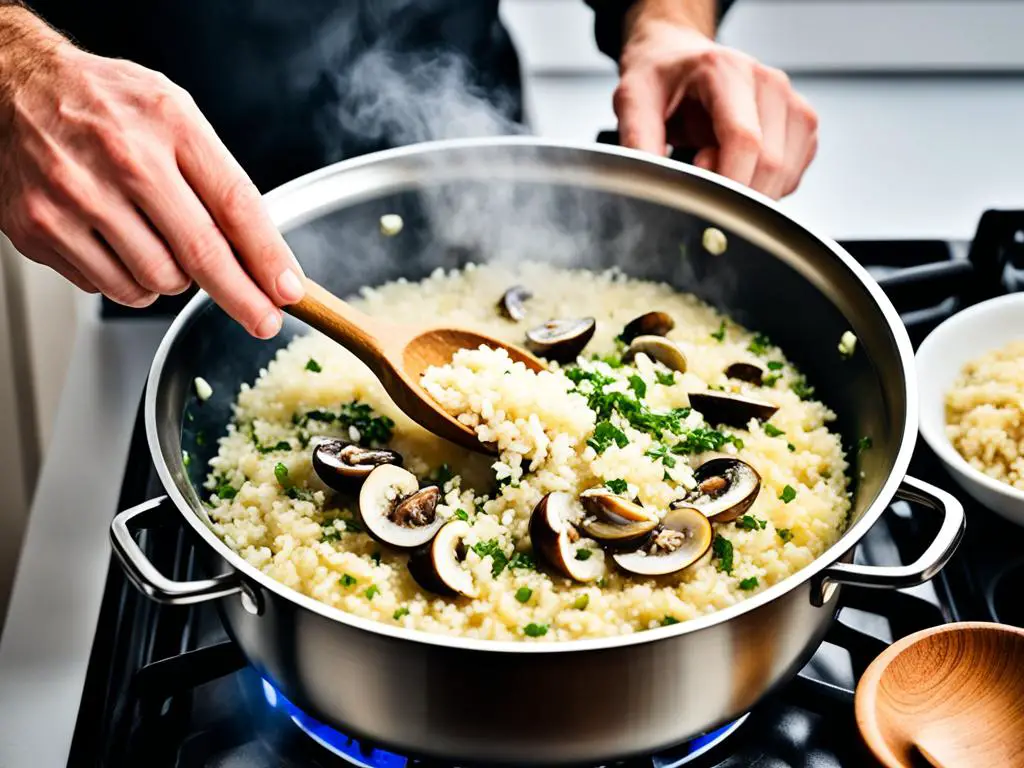
Remember, a great risotto requires patience, attention to detail, and a willingness to experiment with different flavors. So grab your risotto pot and get ready to create a culinary masterpiece that will impress even the most discerning palate!
| Technique | Key Points |
|---|---|
| Sautéing | Create a flavorful base by sautéing onions in olive oil or butter. |
| Toasting | Toast the rice for a couple of minutes to enhance its flavor. |
| Gradual Broth Addition | Add warm broth gradually, stirring constantly, to allow the rice to absorb the liquid and release starches. |
| Finishing Touches | Stir in grated Parmesan cheese and butter for creaminess and depth of flavor. |
| Seasoning | Season with salt and pepper to taste. |
Remember, risotto-making is an art that rewards experimentation, so don’t be afraid to add your own unique twists to create a risotto masterpiece.
Risotto: A Versatile and Nutritious Dish
When it comes to enjoying a delicious meal that also contributes to a balanced diet, risotto is a fantastic option. This Italian dish can be prepared in a variety of ways to suit different tastes and dietary needs. By incorporating whole grain rice, vegetables, lean proteins, olive oil, and reduced-fat cheese, you can create a risotto that is both flavorful and nutritious.
Whole grain rice varieties, such as brown Arborio, are a great choice for risotto as they bring an added dose of fiber and nutrients to the dish. Not only does this contribute to a healthier meal, but it also helps keep you feeling satisfied for longer.
Vegetables are another essential component of a nutritious risotto. By adding ingredients like mushrooms, spinach, or peas, you not only enhance the flavor but also boost the vitamin and mineral profile of your dish. Plus, vegetables can add texture and visual appeal to the final presentation.
If you’re looking to make risotto a complete meal, consider incorporating lean proteins like chicken or seafood. These proteins not only provide essential nutrients but also add heartiness and satiety to the dish. Whether you opt for succulent shrimp, tender chicken, or any other protein of your choice, risotto makes it easy to create a well-rounded and satisfying meal.
For those who are mindful of their fat intake, simple tweaks can be made to the traditional risotto recipe. Substituting butter with heart-healthy olive oil and opting for reduced-fat cheese can help lighten the dish without compromising on flavor.
These substitutions can be seamlessly integrated into the cooking process, allowing you to enjoy a guilt-free, yet delicious, risotto experience.
Risotto allows for endless customization to suit your dietary preferences and nutritional needs. Whether you’re following a vegetarian, gluten-free, or low-fat diet, risotto can be tailored to accommodate various requirements. So go ahead and let your culinary creativity run wild while ensuring a well-balanced and nutritious meal.
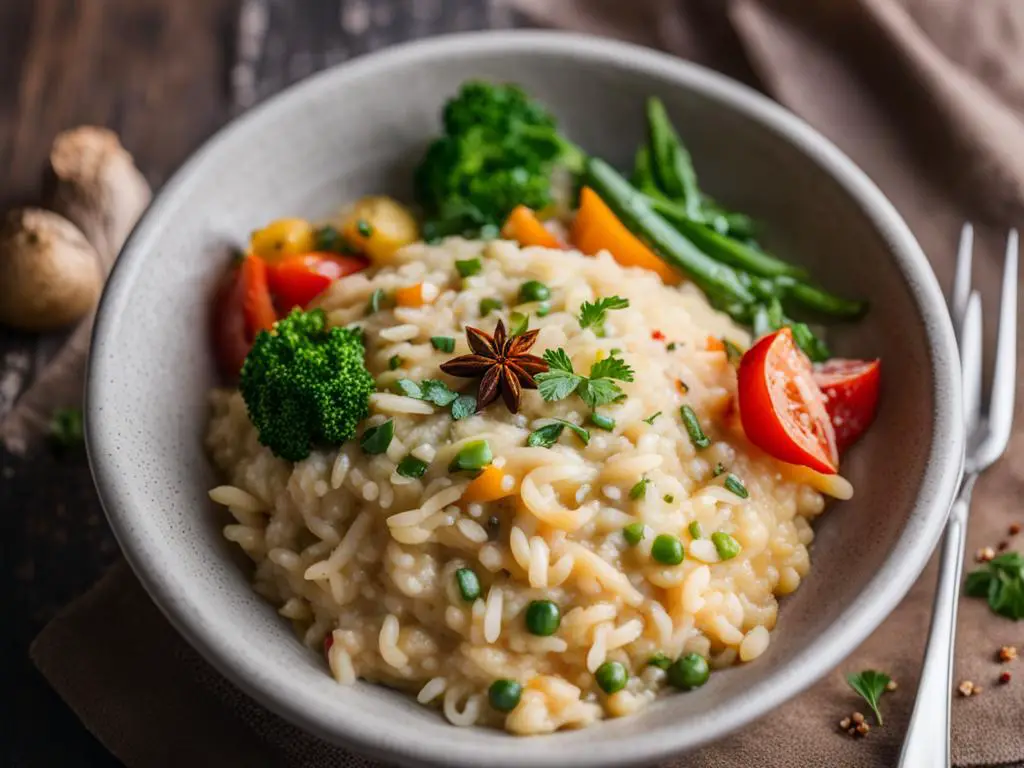
With its flexibility and nutritional benefits, risotto truly stands out as a versatile dish that can contribute to a well-rounded and healthy eating plan. By incorporating whole grain rice, vegetables, lean proteins, olive oil, and reduced-fat cheese, you can create a delicious risotto that checks all the boxes for a balanced and nutritious meal.
Whether you’re cooking for yourself, your family, or guests, risotto is sure to impress with its incredible flavor and healthful qualities.
Risotto: An International Sensation
Despite its Italian origins, risotto has achieved global popularity and can now be found on menus around the world. This beloved dish is a true representation of Italian cuisine, with its rich flavors and creamy texture. But what sets risotto apart is its ability to adapt and evolve, allowing for various international variations and flavor adaptations.
In the warmer months, risotto can be transformed with the addition of fresh herbs, lemon zest, and seasonal vegetables, creating a refreshing twist on the classic Italian dish. Imagine a vibrant risotto bursting with the flavors of fresh basil, zucchini, and juicy cherry tomatoes. It’s a delightful way to embrace the seasonal ingredients and bring a touch of summer to your plate.
On the other hand, when the weather turns colder, heartier versions of risotto emerge, providing comfort and warmth. Picture a creamy risotto infused with earthy pumpkin, meaty mushrooms, or decadent truffles. These winter variations satisfy your palate and provide a cozy indulgence on chilly evenings.
International Flavor Adventures
“Risotto is like a blank canvas waiting to be transformed by the culinary traditions and preferences of different cultures. Its adaptability makes it a perfect vehicle for flavors from around the world.”
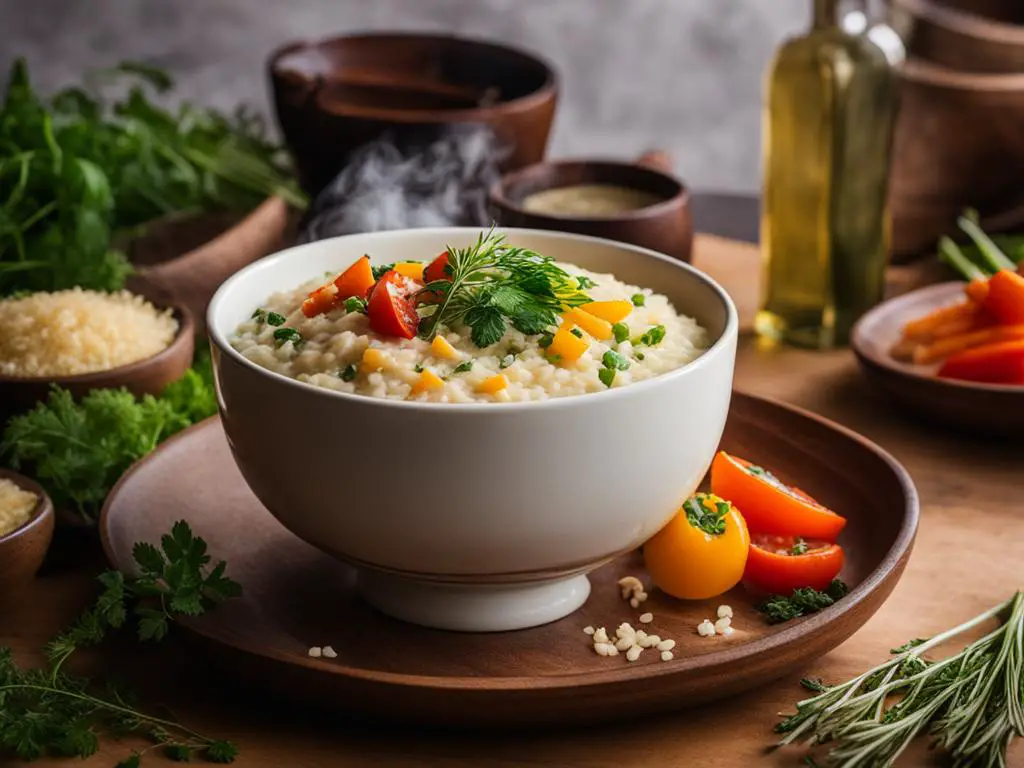
The versatility of risotto allows for endless exploration and flavor experiments. Chefs worldwide have embraced the dish and added their own twist to suit their local cuisine and ingredients. From Asian-inspired risottos with soy sauce and ginger to Latin American spins with spicy chorizo and smoky chipotle, there are no limits to the creative adaptations of this Italian classic.
Furthermore, the cultural significance of risotto cannot be overstated. It has become a symbol of cross-cultural culinary exchange, where chefs and home cooks alike celebrate the fusion of global ingredients with the comforting familiarity of Italian cuisine. Risotto serves as a bridge between culinary traditions, bringing people together through shared love and appreciation for good food.
| Country | Suggested Flavor Adaptations |
|---|---|
| Thailand | Thai curry risotto with lemongrass, coconut milk, and kaffir lime leaves |
| Mexico | Spicy risotto with jalapeños, roasted corn, and smoked paprika |
| Greece | Mediterranean risotto with feta cheese, olives, and sun-dried tomatoes |
| India | Saffron and cardamom-infused risotto with pistachios and raisins |
As you can see, the possibilities for risotto are endless. It’s a dish that has transcended boundaries and captured the hearts and taste buds of people worldwide. So the next time you cook risotto, don’t be afraid to get creative and add your own unique twist. Let your imagination run wild and explore the diverse flavors that make risotto a truly international sensation.
Food Safety and Leftovers: Risotto Precautions
When it comes to enjoying risotto, not only is it important to savor the flavors and textures, but also to prioritize food safety. By following proper handling, cooling, and reheating methods, you can confidently indulge in the deliciousness of this classic dish.
Using fresh ingredients is paramount, especially when including chicken or seafood in your risotto. Ensuring the quality and freshness of these ingredients sets the foundation for a safe and enjoyable meal.
Proper handling techniques are key to preventing any foodborne illnesses. This includes washing your hands thoroughly before and after handling raw ingredients, using separate cutting boards for meats and vegetables, and storing ingredients at the correct temperatures.
Once your risotto is cooked and ready to be enjoyed, it’s essential to handle any leftovers promptly and correctly. Leftover risotto should be cooled quickly to minimize the risk of bacterial growth. Within two hours of cooking, transfer the risotto to shallow containers and refrigerate.
When reheating ftover risotto, it’s important to do so safely to minimize the risk of bacterial contamination. Reheat the risotto only once, ensuring it reaches an internal temperature of 165°F (74°C) throughout.
Remember, proper food safety precautions are vital to enjoy risotto without any concerns. By using fresh ingredients, practicing proper handling techniques, and following cooling and reheating guidelines, you can relish in the flavors and comfort of risotto worry-free!
Risotto Food Safety Precautions:
- Use fresh ingredients, especially when including chicken or seafood.
- Practice proper handling techniques, including washing hands and using separate cutting boards.
- Cool leftover risotto quickly within two hours of cooking.
- Refrigerate leftover risotto in shallow containers to ensure even cooling.
- Reheat risotto only once, ensuring it reaches an internal temperature of 165°F (74°C) throughout.
| Food Safety Precautions | Benefits |
|---|---|
| Using fresh ingredients | Enhanced taste and reduced risk of foodborne illnesses |
| Proper handling techniques | Prevention of cross-contamination and maintaining hygiene |
| Cooling leftover risotto quickly | Minimized bacterial growth and increased safety |
| Refrigerating in shallow containers | Improved cooling and preservation of flavors |
| Reheating risotto properly | Elimination of bacterial contamination and optimal taste |
Remember to prioritize food safety when preparing, handling, and storing risotto. By adhering to these precautions, you can savor the delightful flavors of this beloved dish with confidence.
Conclusion
Ah, risotto! A dish steeped in culinary tradition, celebrated for its versatility and balanced flavors. This Italian masterpiece has captivated taste buds and hearts for centuries, embracing cultural significanc. Whether you’re an experienced home cook or just starting out on your culinary journey, risotto offers a canvas for creative expression.
From its humble origins in Northern Italy to its international fame, risotto has evolved into a symbol of Italian gastronomy. Its adaptability knows no bounds; endless variations emerge from the careful combination of ingredients, offering a symphony of flavors that dance on your palate. The genius lies in the balance achieved, each bite an orchestra of textures and tastes.
So, why not embark on a risotto adventure? Channel your inner chef and experiment with different ingredients, flavor profiles, and seasonal produce. Discover the joy of risotto, where the possibilities are as varied as your imagination.
Prepare to be enchanted by the artistry of risotto, an ode to culinary excellence and cultural heritage. Immerse yourself in the rich tapestry of its history and fall in love with the flavors that have endured through generations. Risotto is more than just a dish; it’s a journey that connects us to the essence of Italian cuisine, inviting us to savor tradition and celebrate the magic of food.
FAQ
Is risotto a rice or pasta dish?
Risotto is a rice dish, not pasta. It is made by combining short-grained rice with various ingredients to achieve a rich and creamy texture.
What is the history of risotto in Italian cuisine?
Rice was introduced to Italy in the 10th century and gradually spread throughout the country. The regions of Vercelli and Lombardy in Northern Italy became the heartland of risotto production.
What are some popular varieties of risotto?
Some notable varieties include Risotto Milanese, Risotto Barolo, Risotto Nero di Seppia, and Risotto Pilota. There are also innovative recipes that experiment with unique ingredients.
What types of rice are used in risotto?
Arborio, Carnaroli, and Vialone Nano are the preferred varieties of rice for making risotto due to their high starch content and ability to absorb flavors without becoming mushy.
What are some key techniques for making risotto?
The process of making risotto involves sautéing onions, toasting the rice, gradually adding warm broth while stirring constantly, and finishing with grated Parmesan cheese and butter.
Can risotto be part of a balanced diet?
Yes, risotto can be part of a balanced diet by incorporating whole grain rice, adding vegetables, and using lean proteins. There are also options to reduce fat by substituting butter with olive oil and using reduced-fat cheese.
Is risotto popular outside of Italy?
Yes, risotto has gained popularity around the world and can be found on menus in various international cuisines. It is a versatile dish that can be adapted to different culinary traditions and preferences.
What are some food safety precautions when preparing and storing risotto?
It is important to use fresh ingredients, handle and cook them properly to avoid foodborne illnesses. Leftover risotto should be cooled quickly and refrigerated within two hours of cooking. Reheating should be done thoroughly.
What is the significance of risotto in Italian cuisine?
Risotto is a dish with a rich culinary tradition that showcases the balance of flavors and textures that Italian cuisine is known for. It offers a connection to a timeless cultural tradition and allows for culinary creativity.
